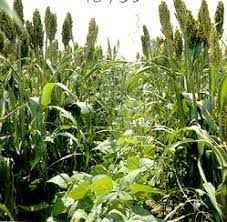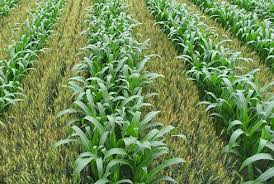Science > Biology > Management of Crop Production > Natural Methods of Nutrient Management
A nutrient Management refers to the maintenance of soil fertility and of plant nutrient supply at an optimum level for sustaining the desired productivity through optimization of the benefits from all possible sources of organic, inorganic and biological components.
Plants require nutrients for their normal growth. Soil supplies mineral nutrients to the crop. These nutrients must be in a form useable by the plants and in concentrations that allow optimum plant growth. Similarly, the soil nutrients must be properly balanced. Soil is a major source of nutrients needed by plants for growth. The three main nutrients are nitrogen (N), phosphorus (P) and potassium (K). Together they make up the trio known as NPK. Other important nutrients are calcium, magnesium, and sulfur. Plants also need small quantities of iron, manganese, zinc, copper, boron, and molybdenum, known as trace elements because only traces are needed by the plant.
In certain areas, farmers grow crop after crop in the same field. The field is never left uncultivated or fallow. The continuous growing of crops makes the soil poorer in certain nutrients. This results in the fall of the yield of the crop. Therefore, farmers have to add manure or fertilizers to the fields to replenish the soil with nutrients.
Natural Methods of Nutrient Management:
Field Fallow:
This is one of the easiest methods of Nutrient Management. When crops are raised, they grow by using nutrients in the soil. After several seasons of planting only one type of crop, the specific nutrients required by that crop become more and more scarce. Thus the soil becomes deficient of the nutrients. In field fallow (free) method the field is kept undisturbed without growing any crop on it for one or more season. When the land is left fallow, the soil is not tilled at all which reduces erosion.
During this period dead plants, animals, and other organic matter gets collected on the land which is decomposed by the microbes present in the soil. A lot of humus grow in it along with soil bacteria. This way soil becomes rich in nutrients. Thus, the vitality of the soil is regained for the next crop. Generally, most farmers don’t let their field fallow, even for just one season.
Crop Rotation:
This is a widely used method of Nutrient Management. When a single crop is grown in one field for many years in a row, the crop will cause the depletion of particular nutrients from the soil. This depletion of nutrients leads to poor plant health and lower crop yield. The nutrients in the soil can be maintained by the method of crop rotation. Crop rotation is the systematic planting of different crops in a particular order over several years in the same growing space. This process helps maintain nutrients in the soil, reduce soil erosion, and prevents plant diseases and pests.
Wheat and rice use up a large amount of nitrogen from the soil. This nitrogen can naturally be replenished if the next crop grown is a legume like a pea or groundnut. The rhizobium bacteria living in symbiotic relation with plants in roots nodule fix atmospheric nitrogen into water-soluble nitrogen compounds. Thus the fertility of soil increases. Legume crops contribute 160 kg of nitrogen per acre to the soil which is equivalent to 95 kg of nitrogen fertilizer.
Advantages of Crop Rotation:
- When a farmer plants leguminous crops, the symbiotic bacteria on nodules of legumes fix atmospheric nitrogen in the form of nitrates.
- The practice of crop rotation reduces the need for the application of fertilizers and minimizes the risk of land and water pollution.
- The farmers can intentionally select the rotation sequence that enhances soil structure when needed.
- Crop rotation enhances the water holding capacity of soils. Soils with a good structure allow fast and thorough absorption of water. Thus water can be conserved.
- During crop rotation when cover crops are planted on the land for most of the rotation cycle, then it minimizes its direct exposure to rain and wind.
- The developed root system of the crop used in rotation ensures that soil particles hold better together.
- If we cultivate the same crop in the same place every growing season, we are creating perfect conditions for the colonies of germs, microbes, and pests to spread more every year. Many pests or diseases prefer only a certain host. By moving the crops and diversifying the cropping sequence, we take away their preferred host and cause a disruption in the annual life cycle of these pests or diseases.
- By implementing crop rotation, the use of fertilizers can be reduced.
- The cultivation of green manure cover crops is an effective strategy of reviving soil fertility on a farm.
Disadvantages of Crop Rotation:
- Crop rotation involves more investment. Because it requires investing more money to buy different seedlings of the different types of crops to be planted.
- Pests and diseases from other crops can spread and infect more crops.
- There is a chance of not getting proper yield from any one crop. If there are no yields for that crop, then the farmer has to wait for the next season.
- The farmer should have good knowledge about crop rotation, there is no need to experiment because there can be nutrient build-up that will take a longer time to correct. Due to improper implementation, the farmer can incur huge losses.
- Crop rotation does not allow a farmer to specialize in a single type of crop.
Mixed Cropping:
Mixed cropping is a farming practice of sowing two or three crops together on the same land. The main focus of mixed cropping is to get produce from at least one crop. If one crop fails due to the shortage of nutrients, heavy rainfall, then the other crop can cover the risk of complete failure. The quantity of yield was not a priority. In this method, any leguminous crop, such as peas, soyabeans or green beans and a cereal crop, like wheat or rice are grown together in the same field. Cotton and groundnut crops are also often grown together.

Advantages of Mixed Cropping:
- Farmers can keep their fields under continuous production. No need for field fallow.
- It enhances the productivity of the farmland and increases the per capita profitability
- The crops used for mixed cropping complement each other.
- It reduces dependency on external inputs and costs.
- It reduces loss due to failure of any one crop.
- It increased biodiversity in the farm, which means fewer risks of pests and diseases outbreak on the farm.
Disadvantages of mixed cropping:
- Farmer should have knowledge of all the crops used for mixed cropping.
- Mixed cropping consists of multiple activities running simultaneously, this makes the control, monitoring, and maintenance of the farm more difficult than a monoculture where only a single activity is run.
- Sometimes one activity may hinder the other activity.
Intercropping:
Intercropping is the companion planting method of growing one crop alongside another. The purpose behind intercropping is to increase yields by doubling up on available growing space. The crops are selected such that the nutrients required by one crop are satisfied by another crop. Intercropping creates biodiversity, This method Nutrient Management requires good knowledge of agronomy.

Advantages of Intercropping:
- Intercropping offers greater financial returns for a farmer. It helps farmers to use the same land to obtain a good yield of diverse produce.
- When the region is vulnerable to weather extremes like drought, torrential rain, hurricanes or cyclones, and various other weather elements, then there are chances that the yield of a given year or season is affected. Due to diverse yields can give some income even if the primary crop gets damaged.
- The crops are selected such that the nutrients required by one crop are satisfied by another crop. The secondary crops can also provide shelter and even protect the primary crops.
Disadvantages of Intercropping:
- Planted crops may compete for the same nourishment including water, which may lead to an unmanageable conflict. It any result in less yield of both the crops.
- There is a need for more fertilizers and water. Hence it is expensive.
- Pest and weed removal, harvesting is more complicated.
However, natural methods of nutrient management of plant are not enough to maintain the fertility of soil and farmers are required to add manures and fertilizers from time to time.
Previous Topic: Plant Nutrients
Next Topic: Organic Fertilizers / Manures